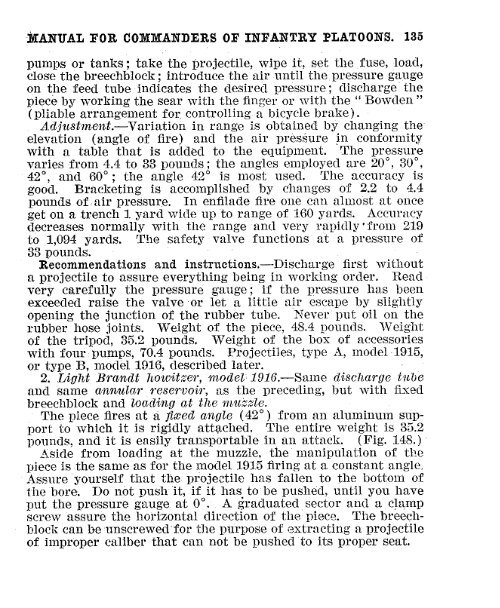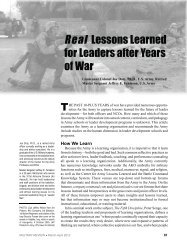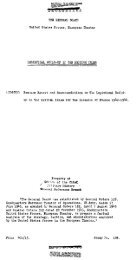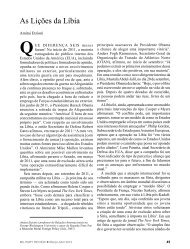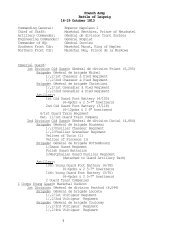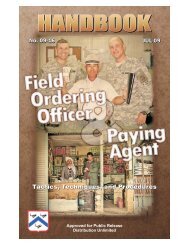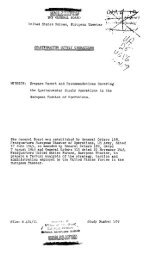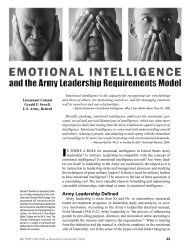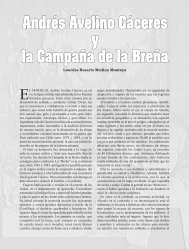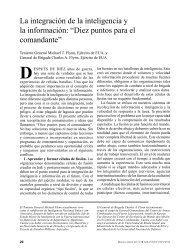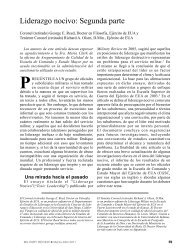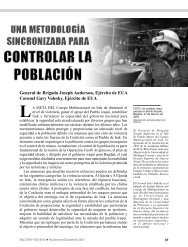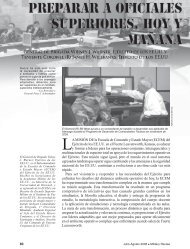manual for commanders of infantry platoons. - US Army Combined ...
manual for commanders of infantry platoons. - US Army Combined ...
manual for commanders of infantry platoons. - US Army Combined ...
You also want an ePaper? Increase the reach of your titles
YUMPU automatically turns print PDFs into web optimized ePapers that Google loves.
~TANUAL FOR CO1IVIMANDERS OF INFANTRY PLATOONS. 135<br />
pumnps or tanks; take the projectile, wipe it, set the fuse, load,<br />
close the breechblock; introduce the air until the pressure gauge<br />
on the feed tube indicates the desired pressure; discharge the<br />
piece by working the sear with the finger or wtithl the "Bowden "<br />
(pliable arrangemnent <strong>for</strong> controlling a bicycle brake).<br />
A~djustment.-Yariation in range is obtained by chanting the<br />
elevation (angle <strong>of</strong> fire) and the air pressure in con<strong>for</strong>mlity<br />
wyithz a table that is added to the equipmlent;. The pressure<br />
varies from 4.4 to 33 pounds; the angles emp~loy~ed are 200, 300L<br />
420, and 600"; the angle 420 is most used. The accuracy is<br />
good. Bracketing is accomplished by ch-anges <strong>of</strong> 2.2 to 4.4<br />
pounds <strong>of</strong> alir pressur~e. In enfilade fire one canl a~lmost at once<br />
get on a trench 1. yard w~ide up to range <strong>of</strong> 160 yards. Accuralcy<br />
decreases normxally with the range and very rapidly from 219<br />
to 1,094 yards. The safety valve functions atta pressure o~f<br />
33 pounds.<br />
Recommendations and instructions.-Dischar.lge first with~out<br />
a projectile to assure everything being in working order. Readl<br />
very carefully the pressure gauge; if the pressure has been<br />
exceeded raise the valve or let a little air escape by slighltly<br />
opening the junction <strong>of</strong> the rubber tube. N~ever~ put oil on the<br />
rubber hose joints. Weight; <strong>of</strong> the piece, 48.41 pounds. W~ieight<br />
<strong>of</strong> the tripod, 35.2 po~unds. Weight <strong>of</strong> the box <strong>of</strong> accessories<br />
with four pumlps, 70.4l pounds. Projectiles, type A, model 1915,<br />
or type B, mlodlel 1916, described later.<br />
2. Light Brandt howitzer-, mzodel 191G.--Same dischLarge tu~be<br />
and samne annulau~r reservoir-, as the preceding, but with fixedl<br />
breechblocki and loading at thze mu~zcle.<br />
The piece fires at a fixedl anzgle (420) fr'omY an alumlinum~ support<br />
to which it is rigidly attached. T'he entire weight is 35.2<br />
pounds, and it is easily transportable in an attack. (Fib. 148.)<br />
Aside from loadiinb at the muzzle, the manipulationn <strong>of</strong> th~e<br />
piece is the samle as <strong>for</strong> the modlel 1915 firing at a constant angle.<br />
Assure yourself that the projec~tile has fallen to the bottom <strong>of</strong><br />
the bore. Do not push it;, if it has to be pushed, until you have<br />
put the pressure gauge at 00. A graduatedl sector and a clamnp<br />
scr~ew assure the hori~zontal direction <strong>of</strong> th~e piece. The breechblock<br />
canl be unscrewved <strong>for</strong> the purpose <strong>of</strong> extracting a projectile<br />
<strong>of</strong> improper cazliber that can not be pushed to its proper seat.


